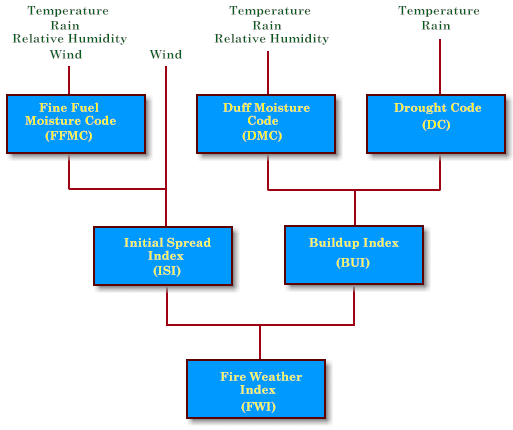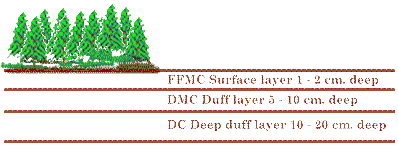Predictive Services - Fuels / Fire Danger - FWI Defined
The Canadian Forest Fire Weather Index (FWI) tracks the effects of weather on forest fuels. In doing so, it gives an estimation of potential fire danger and fire behavior in the area adjacent to a weather station at which the weather is recorded. It is based on the moisture content of three classes of surface forest fuels, plus the effect of wind, on fire behavior.
The FWI system is probably best explained as a bookkeeping system in which, for a particular weather station, fuel moisture is added in the form of precipitation and subtracted in the form of drying. Precipitation is the only input component that will add to fuel moisture while the other inputs of temperature, relative humidity, wind speed, and time of year, control the rate of drying.
The system consists of six components; three primary indexes, or codes, representing fuel moisture for each of the three fuel layers, two intermediate indexes representing rate of spread and fuel consumption, and a final index representing fire intensity as energy output per unit length of fire front.

Weather readings taken at 12:00 solar noon local standard time (not daylight savings time) at weather stations for temperature, rainfall, relative humidity, and wind speed are used as inputs into a computer program that calculates the six indices for each station.

Note: None of these categories have any units ( %, chains/hour, feet etc.) assigned to them.
1. The Fine Fuel Moisture Code (FFMC) represents the moisture content of litter and cured fine fuels, 1-2 cm deep. It expresses the ease of ignition and fuel flammability. FFMC is sensitive to daily changes in temperature, rainfall, relative humidity, and wind speed. Time lag is 2/3 day, which means that it takes two thirds of a day for the fine fuels to react to a change in the weather.
2. The Duff Moisture Code (DMC) represents the moisture content of loosely compacted, decomposing organic matter, 5-10 cm. deep, which determines resistance to control. DMC is sensitive to temperature, rainfall, and relative humidity. Time Lag is 12 days.
3. The Drought Code (DC) represents the deep layer of compacted organic matter, 10-20 cm. deep, which determines resistance to extinguishment. It indicates seasonal drought and smouldering fires in deep duff or large logs. DC is sensitive to temperature and rainfall. Time lag is 52 days.
4. The Initial Spread Index (ISI) represents a numerical rating of fire spread immediately after ignition without the influence of variable fuel quantity (the fuel type isn't considered). It fluctuates with wind speed and time of day. ISI is a combination of FFMC and wind.
5. The Build Up Index (BUI) represents total fuel available for combustion. In the absence of rain, BUI fluctuates little throughout the day. BUI is a combination of DMC and DC.
6. The Fire Weather Index (FWI) represents the intensity of a spreading fire. FWI is a combination of ISI and BUI.
Home | About Us | Disclaimer | Links | Contact Us | Vulnerability Disclosure Policy

|

|
Get Local Weather |


